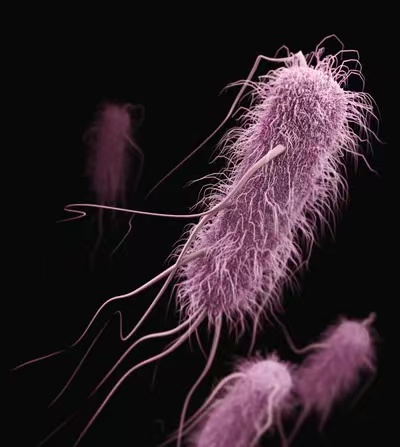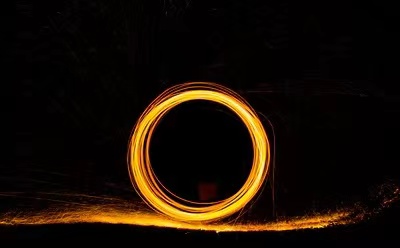创新背景
其他涂层可以有效地杀死细菌,但只有在暴露在对人类有危险的紫外线或非常强的光源下才能有效地杀死细菌,而这些光源不太实用。
创新过程
发表在《自然通讯》(Nature Communications)杂志上的这项研究首次展示了一种光激活的抗菌涂层在低强度的环境光(300勒克斯)下成功杀死细菌,比如病房和候诊室的环境光。以前,类似的涂层需要强光(3000勒克斯)来激活它们的杀伤特性,就像在手术室里发现的那样。
这种新型的杀菌涂层是由化学修饰过的微小簇金镶嵌在带有结晶紫的聚合物中制成的,结晶紫是一种具有抗菌和抗真菌特性的染料。

第一作者、伦敦大学学院化学学系的黄基炳博士表示,像结晶紫这样的染料在杀灭细菌和保持表面无菌方面很有前途,因为它们广泛用于伤口消毒。当暴露在强光下时,它们会产生活性氧,进而通过破坏细菌的保护膜和DNA来杀死细菌。当它们与银、金和氧化锌等金属配对时,这种效应会被放大。
由化学家、化学工程师和微生物学家组成的团队使用一种可扩展的方法创建了这种杀菌涂层,并测试了它在不同光照条件下对控制涂层杀灭金黄色葡萄球菌和大肠杆菌的效果。
样品表面用杀菌涂层或对照涂层处理,然后接种100,000菌落形成单位(CFU)每毫升的金黄色葡萄球菌和大肠杆菌。在200 - 429勒克斯的暗光和白光条件下研究了细菌的生长。

他们发现,在环境光下,单独在聚合物中包裹一层水晶紫的控制涂层并不能杀死这两种细菌。然而,在相同的光照条件下,杀菌涂层使金黄色葡萄球菌在6小时后的生长减少了3.3 log,大肠杆菌在24小时后的生长减少了2.8 log。
大肠杆菌比金黄色葡萄球菌对杀菌涂层有更强的抵抗力,因为它需要更长的时间来达到显著减少表面存活细菌的数量。这可能是因为大肠杆菌的细胞壁有一个双膜结构,而金黄色葡萄球菌只有一个膜屏障。研究小组意外地发现,这种涂层通过产生过氧化氢来杀死细菌,过氧化氢是一种用于隐形眼镜清洁液的相对温和的试剂。它通过化学方式攻击细胞膜,因此需要更长的时间来作用于有更多保护层的细菌。
“我们涂层中的金簇是通过光和湿度的作用产生过氧化氢的关键。考虑到这种簇只包含25个金原子,与类似的涂层相比,这种贵金属所需的量非常少,这使得我们的涂层具有更大的吸引力,”资深作者Asterios Gavriilidis教授(伦敦大学学院化学工程)评论道。
创新价值
为了阻止疾病的传播,它可以被用于覆盖手机屏幕和键盘,以及导管和呼吸管的内部,这是医疗相关感染(HCAIs)的主要来源。
创新关键点
这种涂层通过产生过氧化氢来杀死细菌,过氧化氢是一种用于隐形眼镜清洁液的相对温和的试剂。它通过化学方式攻击细胞膜,因此需要更长的时间来作用于有更多保护层的细菌。
创新主体
伦敦大学学院(University College London,简称:UCL ),1826年创立于英国伦敦,是一所公立研究型大学,为伦敦大学联盟的创校学院、罗素大学集团和欧洲研究型大学联盟创始成员,被誉为金三角名校和“G5超级精英大学”之一。
UCL是伦敦的第一所大学,以其多元的学科设置著称,于REF 2014 英国大学官方排名中,位列全英之冠,享有最多的科研经费。UCL的医学、解剖学和生理学、建筑学、教育学、考古学、计算机科学、计算金融学等学科排名均位居世界前列,与LSE并称为“英国现代经济学研究的双子星”;其人文学院颁发的奥威尔奖则是政治写作界的最高荣誉。
New light-activated coatings are used to kill bacteria
The study, published in the journal Nature Communications, is the first to demonstrate that a light-activated antimicrobial coating successfully kills bacteria at low levels of ambient light (300 lux), such as that found in hospital rooms and waiting rooms. Previously, similar coatings required a bright light (3,000 lux) to activate their killing properties, as was found in the operating room.
The new bactericidal coating is made from tiny clusters of chemically modified gold embedded in a polymer with crystal violet, a dye with antibacterial and antifungal properties.
"Dyes like crystal violet are promising for killing bacteria and keeping surfaces sterile because they are widely used to sterilize wounds," said lead author Dr Ki-bing Huang, from UCL's Department of Chemistry. When exposed to bright light, they produce reactive oxygen species, which in turn kill bacteria by damaging their protective membranes and DNA. This effect is amplified when they are paired with metals such as silver, gold and zinc oxide."
The team of chemists, chemical engineers and microbiologists used a scalable approach to create the bactericidal coating and tested its effectiveness against the control coating against Staphylococcus aureus and Escherichia coli under different light conditions.
The surface of the sample was treated with either a bactericidal coating or a control coating and then inoculated with 100,000 colony-forming units (CFU) per milliliter of Staphylococcus aureus and Escherichia coli. Bacterial growth was studied under dark and white light conditions of 200-429 lux.
They found that a control coating of crystal violet wrapped in the polymer alone did not kill either type of bacteria under ambient light. However, under the same light conditions, the bactericidal coating reduced the growth of Staphylococcus aureus by 3.3 log after 6 hours and E. coli by 2.8 log after 24 hours.
"E. E. coli is more resistant to bactericidal coatings than Staphylococcus aureus because it takes longer to achieve a significant reduction in the number of surviving bacteria on the surface. This may be because the cell wall of E. coli has a double membrane structure, whereas S. aureus has only one membrane barrier, "explained study co-author Dr Elaine Allen (Eastman Institute of Dental Research, University College London).
Unexpectedly, the team found that the coating kills bacteria by producing hydrogen peroxide, a relatively mild reagent used in contact lens cleaning solutions. It chemically attacks the cell membrane, so it takes longer to act on bacteria, which have more protective layers.
"The gold clusters in our coating are key to the production of hydrogen peroxide through the action of light and humidity. Considering that this cluster contains only 25 gold atoms, the amount required for this precious metal is very small compared to similar coatings, making our coating even more attractive, "commented senior author Professor Asterios Gavriilidis (UCL Chemical Engineering).
智能推荐
序列预测创新 | 新逆向计算蛋白质设计框架可提高序列预测速度和准确率
2022-06-29创新结合逆向蛋白质折叠结构进性质和新的结构信息机制,开发新的深度学习模型。
涉及学科涉及领域研究方向前沿医学 | 利用超软电极监测心肌细胞电信号
2022-06-29在纳米网络上采用高可控性的静电纺丝技术,监测心肌细胞化学物理信息同时保证细胞自主无影响运动。
涉及学科涉及领域研究方向微生物学创新 | 全新探究非营养型甜味剂对人体肠道微生物组的影响
2022-11-22通过对照试验表明非营养型甜味剂不是惰性的,它们会对人体产生影响,有些甚至可以改变人类消费者肠道中的微生物组。
涉及学科涉及领域研究方向创新免疫疗法对抗乙型肝炎病毒
2022-08-02伦敦大学学院的科学家们已经发现了一种对抗乙肝病毒(HBV)的新免疫疗法,乙肝病毒是世界上最常见的肝癌病因。
涉及学科涉及领域研究方向